Kanban Principles and Practices Beginners Guide for 2025
Kanban is one of the most popular agile methodologies with project teams thanks to how easy the system is to implement and follow. Still, you should arm yourself with knowledge about kanban principles and practices before you make the switch.
Take a look at the best project management software suites and you’ll see that most of them support kanban. Kanban is one of the easiest agile methodologies to use, and it supports multiple industries. Still, before you switch from traditional project management methods, you need to understand kanban principles and practices.
In this guide, we’ll explain the four kanban principles and the six kanban practices to follow if you want to be successful while using this agile methodology. We’ll also offer some helpful tips on how to implement kanban in your workplace. We know you’re eager to learn, so let’s jump right in.
-
06/21/2024
Added custom graphics.
What Are the 4 Core Principles of Kanban?
The four core principles of kanban are: start with what you are doing now, pursue incremental improvement & evolutionary change, respect the existing processes, roles, responsibilities and titles, and encourage acts of leadership.
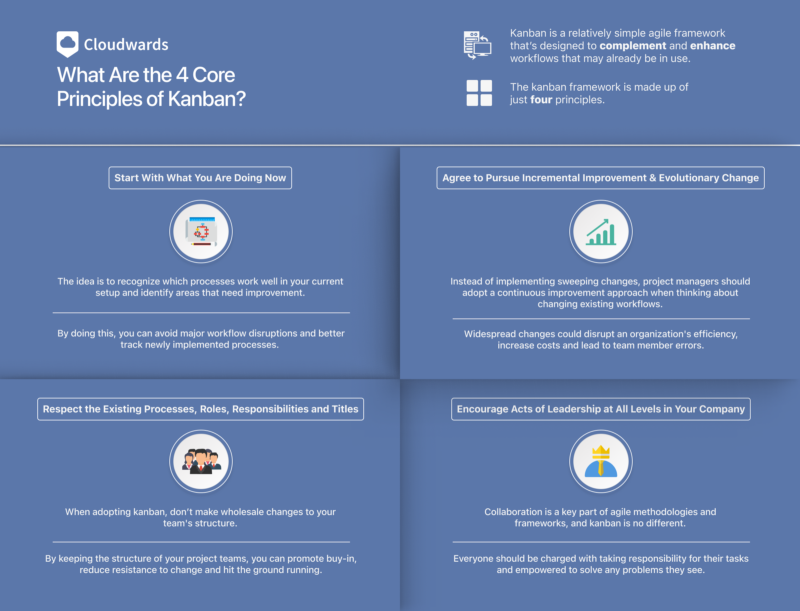
These four principles sound complex, but Kanban is actually a relatively simple agile framework that’s designed to complement and enhance workflows that may already be in use. Below we’ll go through the four principles in more detail.
1. Start With What You Are Doing Now
Implementing the kanban methodology does not mean upending your current workflows or structures. The idea is to recognize which processes work well in your current setup and identify areas that need improvement. By doing this, you can avoid major workflow disruptions and better track newly implemented processes.
2. Agree to Pursue Incremental Improvement & Evolutionary Change
Adopting a new project management workflow is challenging. Instead of implementing sweeping changes, project managers should adopt a continuous improvement approach when thinking about changing existing workflows. Widespread changes could disrupt an organization’s efficiency, increase costs and lead to team member errors.
Implementing an agile framework like kanban should be done incrementally. In fact, you need only look at the scrum framework and other agile methods to see that incremental improvements are key agile values. Kanban recognizes this and encourages teams to evolve experimentally by changing one process at a time so teams can get used to the changes.
3. Respect the Existing Processes, Roles, Responsibilities and Titles
When adopting kanban, don’t make wholesale changes to your team’s structure. Kanban is designed to improve processes and complement current organizational structures, not upend them.
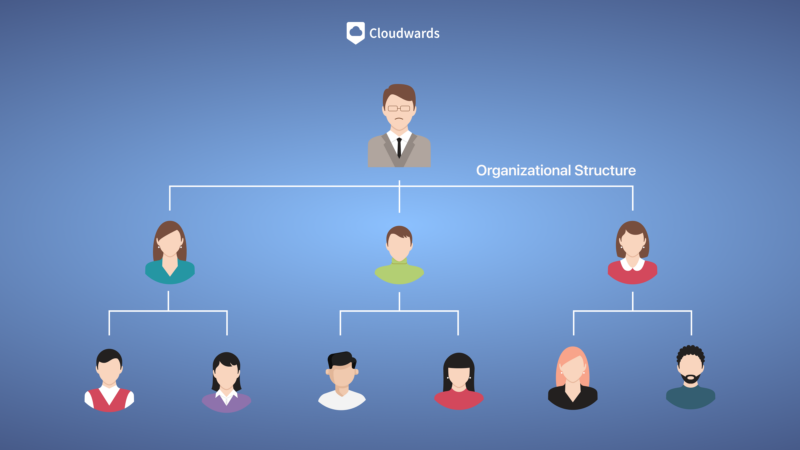
By keeping the structure of your project teams, you can promote buy-in, reduce resistance to change and hit the ground running. This applies to small businesses and large organizations working on multiple projects.
4. Encourage Acts of Leadership at All Levels in Your Company
Collaboration is a key part of agile methodologies and frameworks, and kanban is no different. Kanban provides every team member a global view of a project, which includes tasks to be worked on, tasks being worked on, potential bottlenecks and work-in-progress (WIP) limits.
With this in mind, everyone should be charged with taking responsibility for their tasks and empowered to solve any problems they see. Members of software development teams, senior management and project managers alike, should encourage leadership by tackling problems and issues when they see them.
What Are the 6 Kanban Practices?
The six kanban practices are: visualize workflow elements, limit work in progress, manage flow, make process policies, implement feedback loops, and improve collaboratively. We’ll take a look at these six core practices that all kanban teams should follow to ensure success.
1. Visualize Workflow Elements
Project managers, team leaders and all team members must be able to see the tasks on their plate before they get to work. The kanban method uses kanban boards, which offer one of the best ways to visualize an entire project’s list of tasks and jobs.
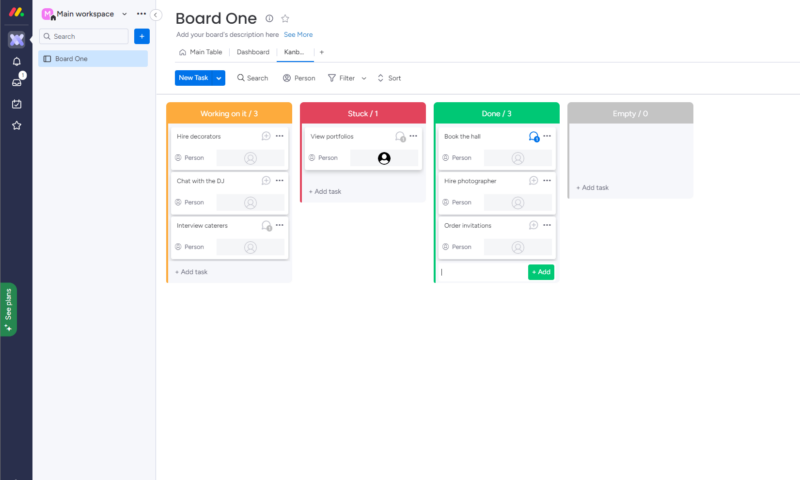
A simple kanban board houses columns that represent stages of work, such as “to do,” “in progress” and “done.” In each column, you’ll find kanban cards that contain task details, due dates, files, custom fields related to your current project and more. As tasks are completed, team members simply move the cards from left to right through the various stages of the project.
2. Limit Work in Progress (WIP)
Projects have many moving parts and often have many tasks that must be completed. As such, it can be easy for a project manager to assign multiple tasks to a team member without realizing they may have too much on their plate. Fortunately, kanban champions work-in-progress limits (WIP).
You can strike a balance by implementing a WIP rule stating that team members can only have a certain number of tasks assigned to them at any given time. Thanks to kanban’s visual nature, senior leaders can quickly see which employees have too much or too little work.
It’s worth noting that kanban is a pull system, not a push system. Push systems can easily overwhelm team members with tasks they’re not ready for, as they are simply assigned work whenever a task is ready. A pull system states that new tasks should only be assigned to employees when the employees are ready.
3. Manage Flow
Kanban boards are one of the best tools for identifying bottlenecks in your workflow. Each stage of the kanban system process has a dedicated column, making it easy to see where a holdup might be occurring. For example, if you have a slow-moving column for image proofing, you can identify the bottleneck and meet with your designers to understand the reason for the delay.
4. Make Process Policies
Once you’ve decided to adopt the kanban system (or any agile methodology, for that matter), take the time to create policies that cover processes, issues and rules of use so every team member is on the same page. The last thing you want is a poor interpretation of kanban processes, which can lead to inefficiencies, extra expenditures and potential conflict.
5. Implement Feedback Loops
Read the agile manifesto and you’ll quickly discover that communication is a key part of agile frameworks. Managers should hold frequent meetings with team members and encourage open, honest communication so issues and problems can be discussed and resolved quickly.
During meetings, ask how everyone likes using the board, whether the project stages are appropriate and for general feedback on kanban. Then, take that feedback and implement incremental changes that lead to continual improvement of the system and processes.
6. Improve Collaboratively
Collaboration is another key component of agile frameworks, including kanban. The idea is to bring teams together via the collaboration tools found in some of the best free project management software or in person so that problems can be discussed and addressed internally and externally with clients and project stakeholders.
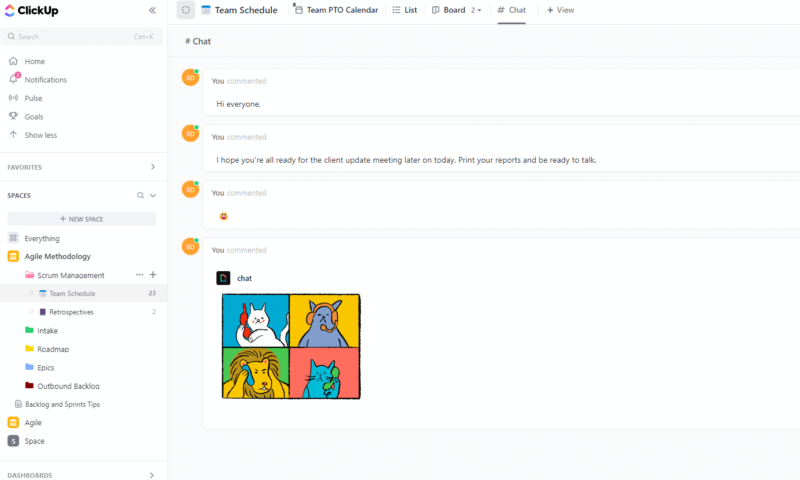
collaboration tools for in-house and distributed teams.
In our monday.com review, you can learn about collaboration tools and integrations that can help distributed teams work together. In our ClickUp review, you can learn about mind maps that can help teams solve complex problems. As a project manager, you should do everything in your power to use any tools you can get your hands on to encourage collaboration.
The Key to Implementing Kanban Principles and Practices
Knowing the four kanban principles and six kanban practices is one thing, but implementing them is another. Below, we’ll look at how you can successfully implement kanban without causing a change management crisis.
- Learn the basics: Before you consider adopting kanban, you need to understand what it is and is not. Our kanban guide will help you determine whether it’s suitable for the types of projects you work on.
- Hire a change manager: Managing change can be challenging. If you’re hesitant to implement a new workflow process, consider hiring a change manager who can help communicate why the change is being made, avert conflict and put minds at ease so the change is not rejected.
- Communicate openly: If you’re switching from a traditional project management methodology like waterfall, your team might not be used to frequent meetings and communication. Start by having a frank discussion about kanban and why switching to an agile method like kanban could benefit the entire organization.
- Make small, incremental changes: Don’t ruffle feathers by changing established practices overnight. Implement kanban incrementally, gather feedback from the whole team and strive to continuously improve.
- Pick good kanban software: Many project management tools support kanban. Zoho Projects offers robust kanban boards. You can learn about them in our Zoho Projects review. Alternatively, check out our roundup of the best kanban apps.
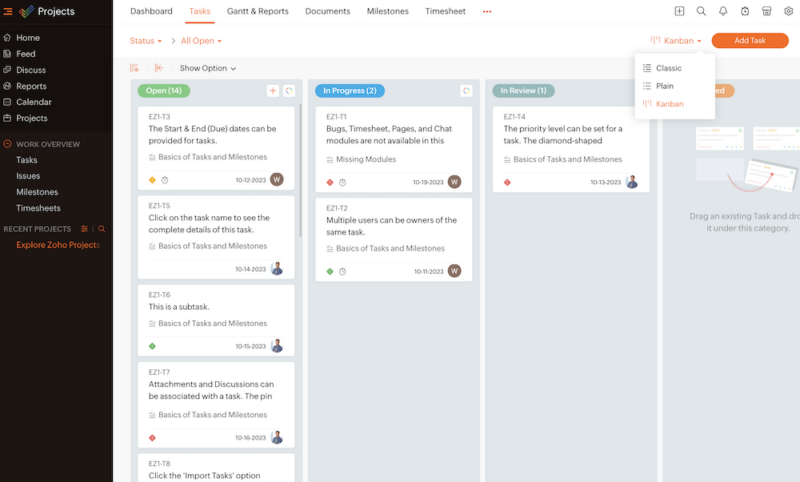
Final Thoughts
Kanban is one of the easiest agile practices to implement, and kanban boards give project managers a global view of tasks. Kanban encourages collaboration and is suitable for everything from software development to marketing. If teams follow the kanban principles and practices discussed in this guide, they can achieve success.
Are you considering switching to kanban from a traditional method? Which elements of kanban appeal to you? Do you use any project management software that includes kanban boards? Let us know in the comments, and check out our guide to the Kaizen method too. Thanks for reading.
FAQ: Core Kanban Practices & Principles
Kanban is a methodology that uses kanban boards to track project tasks as they move through various project stages.
The basic principle of the kanban framework is work visualization. Project managers can see the status of any task at a glance, no matter which stage of the workflow it’s in.
A kanban board is an area that contains lists representing the stages of your project. A kanban card represents a task that is moved from left to right through the lists on a kanban board.
Kanban can reduce workflow inefficiencies, increase collaboration on a project team and help make teams more adaptable and flexible regarding project changes.
Sources:


